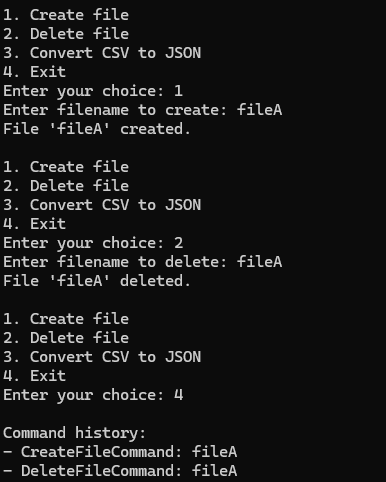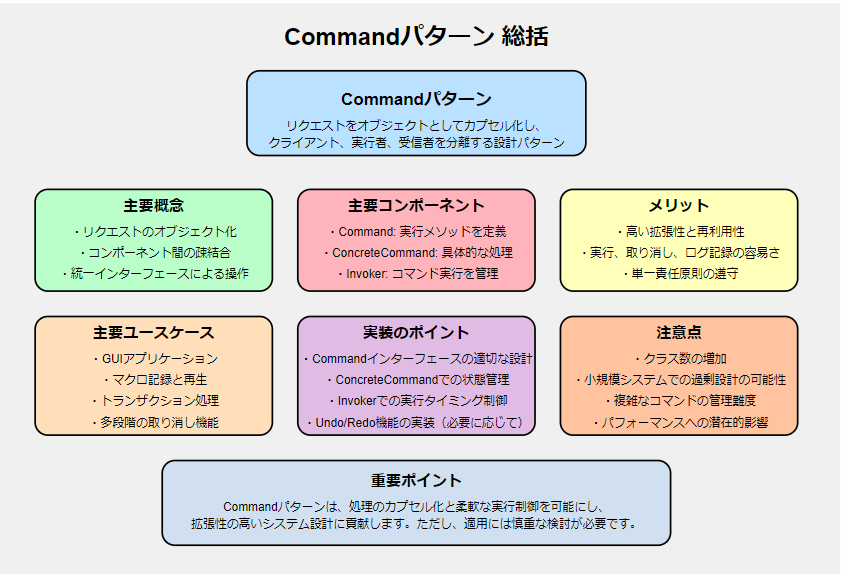はじめに
コマンドラインツールを開発する際、機能の追加や変更が容易で、拡張性の高いアプリケーションを作ることは重要です。この記事では、Commandパターンを活用してコマンドラインツールの拡張性を高める方法について解説します。
なぜCommandパターン?
振る舞いに関するデザインパターン
Commandパターンは、GoF(Gang of Four)デザインパターンの1つで、リクエストをオブジェクトとしてカプセル化することができます。このパターンを使うことで、コマンドの追加や変更が容易になり、アプリケーションの拡張性が向上します。
ユースケース
Commandパターンは以下のような状況で特に有効です:
- 複数のコマンドを持つCLIアプリケーション
- コマンドの実行、取り消し、やり直しが必要なアプリケーション
- コマンドの実行をキューに入れて後で処理したい場合
- コマンドの履歴を管理したい場合
- データ変換処理を行うアプリケーション
- 例:異なるファイル形式間の変換(CSV→JSON、XML→YAML等)
- 各変換処理を個別のCommandとして実装することで、新しい変換形式の追加が容易になります
- バッチ処理システム
- 複数の処理ステップをCommandとして実装し、それらを組み合わせて複雑なバッチ処理を構成できます
- GUIアプリケーションのアクション管理
- ボタンクリックやメニュー選択などのユーザーアクションをCommandとして実装することで、UIと処理ロジックを分離できます
- ゲーム開発におけるプレイヤーアクション
- プレイヤーの各アクション(移動、攻撃、アイテム使用など)をCommandとして実装することで、リプレイ機能やアクションの取り消しが実現しやすくなります
メリット
- 拡張性: 新しいコマンドを追加する際、既存のコードを変更せずに新しいクラスを作成するだけで済みます。
- 単一責任の原則: 各コマンドは独立したクラスとして実装されるため、責任が明確に分離されます。
- 柔軟性: コマンドの実行、取り消し、再実行などの操作を簡単に実装できます。
- テスト容易性: 各コマンドを個別にテストできるため、ユニットテストが書きやすくなります。
- 遅延実行: コマンドオブジェクトを作成し、後で実行することができます。これはバッチ処理や非同期処理に有用です。
- パラメータ化: コマンドの実行に必要な情報をコマンドオブジェクト内にカプセル化できるため、複雑な操作も簡単に実行できます。
- ロギングと監査: 各コマンドの実行を容易に記録できるため、システムの動作履歴や監査ログの実装が簡単になります。
- トランザクション管理: 複数のコマンドをグループ化してトランザクションとして扱うことができ、全体の成功または失敗を管理しやすくなります。
デメリット
- クラス数の増加: 新しいコマンドごとに新しいクラスを作成する必要があるため、クラス数が増えます。
- 複雑さの増加: 単純な機能でも、インターフェースやクラスの階層構造が必要になるため、初期の実装が複雑になる可能性があります。
- オーバーヘッド: 小規模なアプリケーションや単純な操作の場合、Commandパターンの導入が過剰な設計になる可能性があります。
実装例
以下に、Pythonを使用してCommandパターンを実装した簡単な例を示します。この例では、ファイル操作を行うコマンドラインツールを想定しています。
from abc import ABC, abstractmethod
# Command インターフェース
class Command(ABC):
@abstractmethod
def execute(self):
pass
# 具体的なコマンドクラス
class CreateFileCommand(Command):
def __init__(self, filename):
self.filename = filename
def execute(self):
with open(self.filename, 'w') as f:
f.write('')
print(f"File '{self.filename}' created.")
class DeleteFileCommand(Command):
def __init__(self, filename):
self.filename = filename
def execute(self):
import os
os.remove(self.filename)
print(f"File '{self.filename}' deleted.")
# データ変換コマンドの例
class ConvertCSVtoJSONCommand(Command):
def __init__(self, input_file, output_file):
self.input_file = input_file
self.output_file = output_file
def execute(self):
import csv
import json
with open(self.input_file, 'r') as csv_file:
csv_data = list(csv.DictReader(csv_file))
with open(self.output_file, 'w') as json_file:
json.dump(csv_data, json_file, indent=2)
print(f"Converted '{self.input_file}' to '{self.output_file}'")
# Invoker クラス
class FileManager:
def __init__(self):
self.history = []
def execute_command(self, command):
command.execute()
self.history.append(command)
# Client コード
if __name__ == "__main__":
file_manager = FileManager()
while True:
print("\n1. Create file")
print("2. Delete file")
print("3. Convert CSV to JSON")
print("4. Exit")
choice = input("Enter your choice: ")
if choice == '1':
filename = input("Enter filename to create: ")
file_manager.execute_command(CreateFileCommand(filename))
elif choice == '2':
filename = input("Enter filename to delete: ")
file_manager.execute_command(DeleteFileCommand(filename))
elif choice == '3':
input_file = input("Enter input CSV filename: ")
output_file = input("Enter output JSON filename: ")
file_manager.execute_command(ConvertCSVtoJSONCommand(input_file, output_file))
elif choice == '4':
break
else:
print("Invalid choice. Please try again.")
print("\nCommand history:")
for command in file_manager.history:
print(f"- {command.__class__.__name__}: {command.filename if hasattr(command, 'filename') else ''}")
この実装例では、Commandインターフェースと具体的なコマンドクラス(CreateFileCommand、DeleteFileCommand、ConvertCSVtoJSONCommand)を定義しています。FileManagerクラスがInvokerとして機能し、コマンドの実行と履歴の管理を行います。
実行結果の例:
まとめ
Commandパターンを活用することで、コマンドラインツールの拡張性と保守性を大幅に向上させることができます。新しい機能を追加する際も、既存のコードに影響を与えることなく、新しいコマンドクラスを追加するだけで済むため、アプリケーションの成長に合わせて柔軟に対応できます。
このパターンは、コマンドラインツールに限らず、データ変換処理、バッチ処理システム、GUIアプリケーション、ゲーム開発など、様々な分野で活用できる強力なデザインパターンです。特に、アクションの履歴管理、取り消し機能、遅延実行が必要な場面で真価を発揮します。
ただし、小規模なプロジェクトや単純な機能しか持たないツールの場合、Commandパターンの導入がオーバーエンジニアリングになる可能性もあります。プロジェクトの規模や将来の拡張性の要件を考慮して、適切に判断することが重要です。
Commandパターンを適切に活用することで、より柔軟で保守性の高いソフトウェアを設計することができます。ぜひ、自分のプロジェクトに取り入れてみてください。


